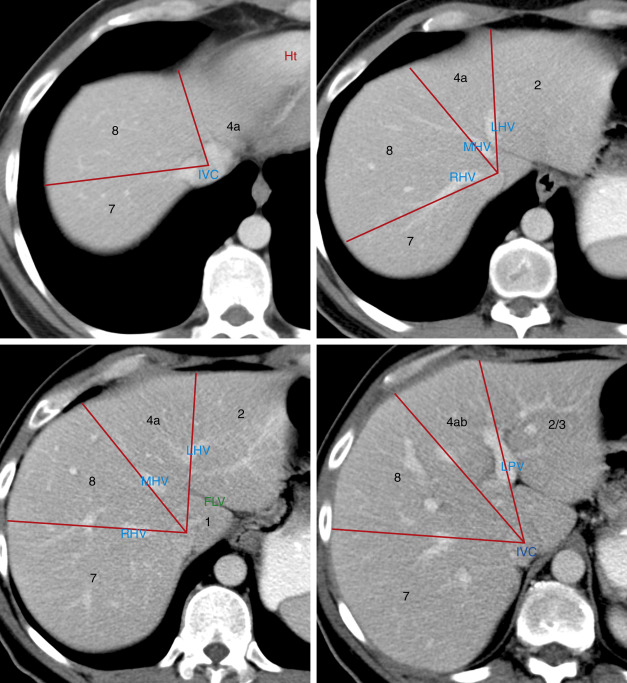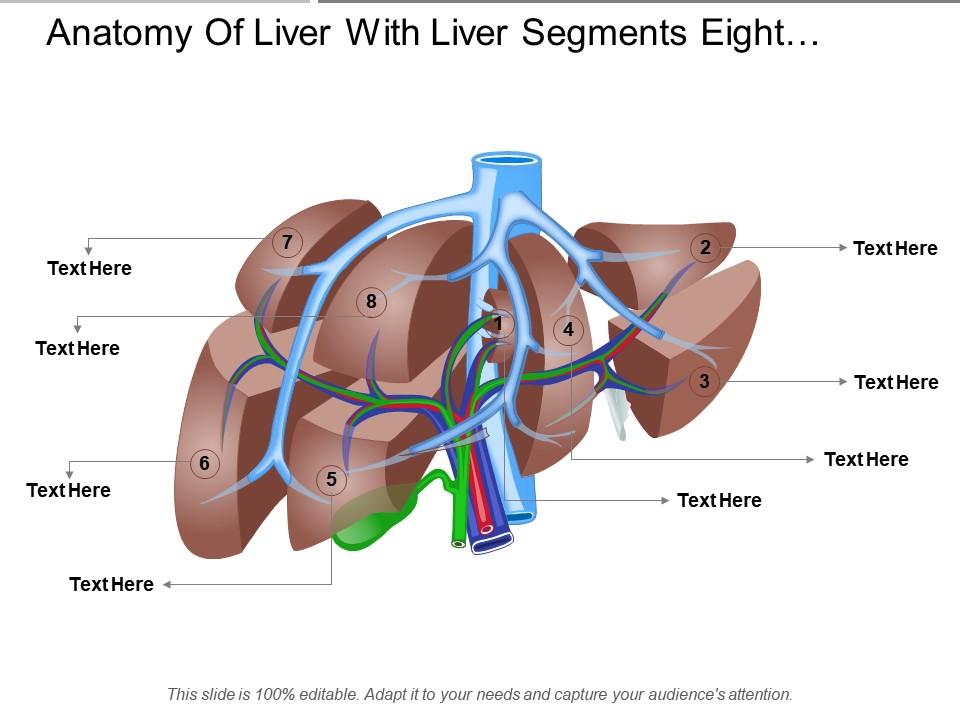
bismuth of liver Google Search Radiology, Ultrasound, Liver anatomy
Liver lobules are the basic functional units of the liver. They are classically described ('classic lobules') as hexagonal structures made of six vertically aligned portal canals with a central vein.

Liver Anatomy Segments
A liver segment is one of eight segments of the liver as described in the widely used Couinaud classification (named after Claude Couinaud) in the anatomy of the liver.This system divides the lobes of the liver into eight segments based on a transverse plane through the bifurcation of the main portal vein, arranged in a clockwise manner starting from the caudate lobe.

Couinaud’s Liver Segments Sonographic Tendencies Segmentation
Segmental anatomy Traditionally, the liver was divided into four anatomical lobes: the right, left, caudate and quadrate lobes.

Couinaud classification of hepatic segments Radiology Reference
Segmental anatomy according to Couinaud. Click to enlarge. Couinaud classification The Couinaud classification of liver anatomy divides the liver into eight functionally indepedent segments. Each segment has its own vascular inflow, outflow and biliary drainage.

Segmental Anatomy Of Liver
Hepatic segmentation Segmentatio hepatis Definition The hepatic segmentation (lobes, parts, divisions and segments) is the oganization of the liver into parts, divisions and segments.

Сегменты печени схема анатомия
The liver has the capacity to store enough vitamin A to prevent a deficiency for as long as 1-2 years 4 and enough vitamin D and vitamin B 12 to prevent deficiency for 1-4 months. The liver also stores glycogen, fats, and amino acids and can metabolize them into glucose or vice versa, depending on the body's needs.
Radiopaedia CTscan Hepatic segments coronal section labels
Segments segment 1 (I) is the caudate lobe bounded posterolaterally by the fossa for the inferior vena cava, anteriorly by the ligamentum venosum, and inferiorly by the porta hepatis its inferior portion is subdivided into a lateral caudate process and a medial papillary process 6 may receive its supply from both the right and the left portal vein

Couinaud classification of hepatic segments Radiology Reference
The authors developed a simplified description of the segmental anatomy of the liver on the basis of the Couinaud nomenclature. This approach was demonstrated with normal in vivo sonographic images and livers dissected in corresponding planes. The branches of the portal vein, which lead to the center of individual segments, are used as key landmarks in the determination of segmental location.

Liver Radiology Key
Indications Liver ultrasound is commonly utilized in the evaluation of various hepatic conditions. The most frequent indications include 1,2: screening for hepatic disease in at-risk populations (e.g. hepatocellular cancer screening in cirrhotic patients) investigation of abnormal liver function tests

From the Angio Suite to the γCamera Vascular Mapping and 99mTcMAA
The most widely accepted model for liver segmental anatomy was first described by Couinaud (Couinaud 1957), and then popularised by Bismuth (Bismuth 1982; Bismuth et al. 1982; Majno et al. 2014), and is now the most commonly used in Europe. According to these authors, the liver is composed of eight anatomical segments, characterised by.

Radiology Assistant Liver Segments
In a portal venous phase CT, the right, middle, and left hepatic veins are usually filled with contrast-mixed blood and can be seen emptying into the inferior vena cava, which is found along the back side of the liver. The portal and hepatic veins divide the liver into segmental anatomy that allows radiologists and surgeons to be very specific.

Liver Anatomy Segments
Abstract The availability of intra-arterial hepatic therapies (radio and/or chemo-embolisation, intra-arterial hepatic chemotherapy) has convinced radiologists to perfect their knowledge of the anatomy of the liver arteries. These sometimes, complex procedures most often require selective arterial catheterization.

Diagram Of Liver Human Liver With Labels Illustration Stock Photo Alamy
1/4 Synonyms: none The liver is the primary processing facility of the body. The majority of the substances that are ingested, and subsequently digested, are absorbed from the lumen of the small intestines and passed to the liver by way of the hepatic portal vein. This organ is not only special due to its function, but also due to its organization.

Anatomy of the liver segments Liver anatomy, Diagnostic medical
sectorial branches will separate each sector of the right liver into two segments (5/8 and 6/7, respectively). In practice, it is convened that all these separations (sectorial and segmental) in the right liver occur at the level of the portal bifurcation. In the left liver, the left portal branch describes an arch towards the round ligament.

Couinaud’s Liver Segments Sonographic Tendencies Segmentation
Segmental anatomy according to Couinaud. Use your right fist to represent the liver segmental anatomy. Para-sagittal Left Ultrasound image. Sagittal Midline Ultrasound image. The Ligamentum venosum is highlighted in orange. lhv:Left hepatic vein ivc: Inferior vena cava Ultrasound image- Para-sagittal Midclavicular.

Pin on XR Diagram Explained
Note the liver segments (labeled in B) and the right portal vein ligation (yellow arrow in A). (C) Illustration of the second stage of ALPPS shows the areas of tumor resection (arrowheads and dashed lines) performed during the first stage in the FLR. Right hepatectomy or right trisectionectomy is performed after 10-20 days (ie, the waiting.